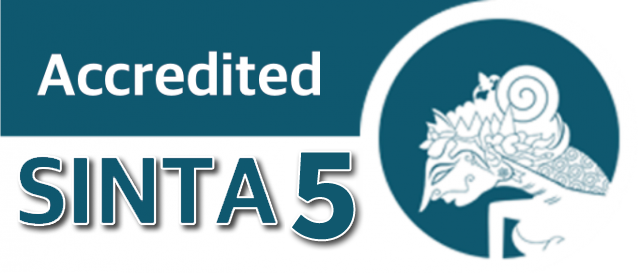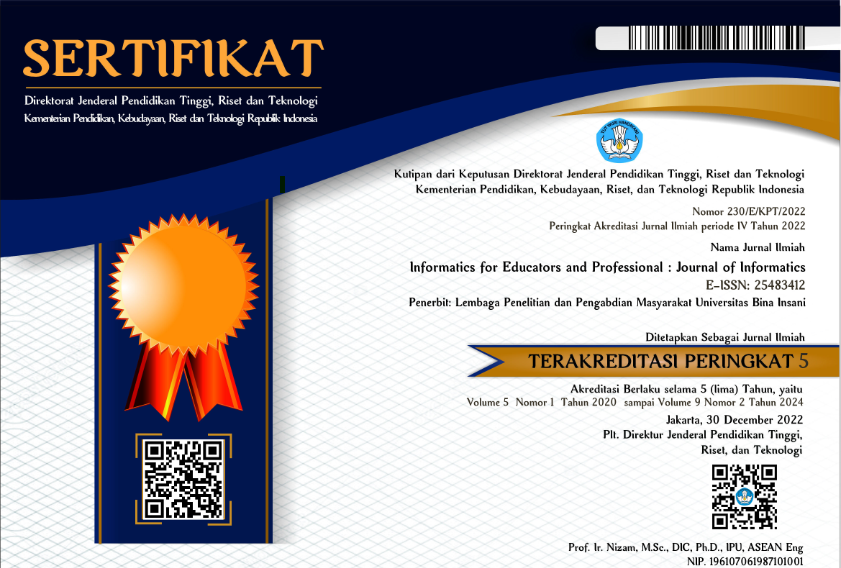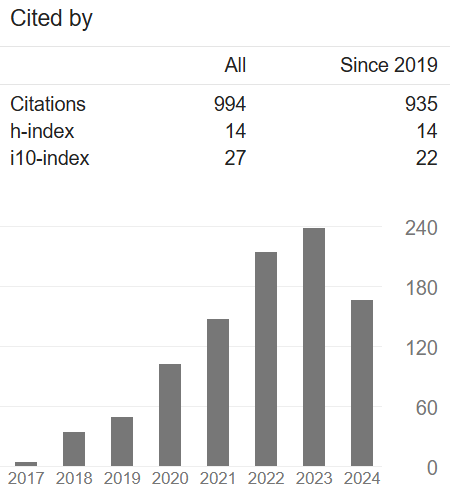Prediksi Gejala Autism Spectrum Disorders pada Remaja Menggunakan Optimasi Particle Swarm Optimization dan Algoritma Support Vector Machine
Abstract
Abstrak: Telah ada peningkatan prevalensi diagnosis Autism Spectrum Disorder (ASD) secara global selama dekade terakhir. Perkiraan prevalensi ASD yang diperbarui dan keseluruhan di Asia akan membantu para profesional kesehatan untuk mengembangkan strategi kesehatan masyarakat yang relevan. Dalam penelitian ini, mengusulkan metode untuk prediksi gejala ASD menggunakan teknik integrasi seleksi fitur PSO dan algoritma Support Vector Machine. Penelitian ini menggunakan dataset dari UCI repository. Model yang diusulkan meliputi penerapan seleksi fitur menggunakan particle swarm optimization (PSO), dengan algoritma pengklasifikasi. Hasil akhir akan dilakukan perbandingan pengujian dan analisa terhadap model prediksi yang memiliki tingkat akurasi tertinggi atau terbaik dalam prediksi gejala ASD. Dalam penelitian ini menggunakan dataset UCI repository yaitu data ASD pada remaja, data tersebut memiliki jumlah data sebanyak 104 instance dan 21 atribut, 41 orang tidak menderita ASD dan 63 orang menderita ASD, tools yang digunakan untuk menerapkan model usulan menggunakan aplikasi Weka versi 3.8.4. Untuk mengetahui model usulan yang diajukan pada penelitian ini, pertama menguji dengan klasifikasi tunggal SVM, dan kedua, menguji dengan seleksi fitur PSO dan algoritma klasifikasi SVM. Untuk mengetahui apakah seleksi fitur PSO berpengaruh terhadap performa algoritma klasifikasi SVM. Pengujian pertama, nilai akurasi yang dihasilkan oleh algoritma klasifikasi SVM adalah sebesar 89.42%, dan nilai AUC sebesar 0.891. Berdasarkan pengujian yang kedua yaitu menggunakan seleksi fitur PSO, seleksi fitur PSO dapat meningkatkan performa algoritma klasifikasi SVM sebesar 2,88% dan nilai AUC sebesar 0,024.Kata kunci: Autism Spectrum Disorder, Particle Swarm Optimizatio, Support Vector Machine
Abstract: There has been an increase in the prevalence of diagnoses of Autism Spectrum Disorder (ASD) globally over the past decade. Updated and overall ASD prevalence estimates in Asia will help health professionals to develop relevant public health strategies. In this study, proposing a method for ASD symptom prediction using PSO feature selection integration techniques and the Support Vector Machine algorithm. This study uses a dataset from the UCI repository. The proposed model includes the application of feature selection using particle swarm optimization (PSO), with the classification algorithm. The final result will be a comparison test and analysis of prediction models that have the highest or best accuracy in predicting ASD symptoms. In this study using the UCI repository dataset, ASD data on adolescents, the data has 104 data and 21 attributes, 41 people do not suffer from ASD and 63 people suffer from ASD, tools used to implement the proposed model using the Weka application version 3.8.4 . To find out the proposed model proposed in this study, firstly testing with SVM single classification, and secondly, testing with PSO feature selection and SVM classification algorithm. To find out whether the PSO feature selection affects the performance of the SVM classification algorithm. The first test, the accuracy value generated by the SVM classification algorithm is 89.42%, and the AUC value is 0.891. Based on the second test using PSO feature selection, PSO feature selection can improve the performance of the SVM classification algorithm by 2.88% and the AUC value of 0.024.
Keywords: Autism Spectrum Disorder, Particle Swarm Optimizatio, Support Vector Machine.
References
[1] L. Xu, Q. Hua, J. Yu, and J. Li, “Classification of autism spectrum disorder based on sample entropy of spontaneous functional near infra-red spectroscopy signal,†Clin. Neurophysiol., 2020, doi: 10.1016/j.clinph.2019.12.400.
[2] J. Jennings Dunlap, “Autism Spectrum Disorder Screening and Early Action,†J. Nurse Pract., vol. 15, no. 7, pp. 496–501, 2019, doi: 10.1016/j.nurpra.2019.04.001.
[3] E. Feczko et al., “Subtyping cognitive profiles in Autism Spectrum Disorder using a Functional Random Forest algorithm,†Neuroimage, vol. 172, pp. 674–688, 2018, doi: 10.1016/j.neuroimage.2017.12.044.
[4] E. Rydzewska et al., “General health of adults with autism spectrum disorders – A whole country population cross-sectional study,†Res. Autism Spectr. Disord., vol. 60, no. January 2018, pp. 59–66, 2019, doi: 10.1016/j.rasd.2019.01.004.
[5] E. Gordon-Lipkin, A. R. Marvin, J. K. Law, and P. H. Lipkin, “Anxiety and mood disorder in children with autism spectrum disorder and ADHD,†Pediatrics, vol. 141, no. 4, 2018, doi: 10.1542/peds.2017-1377.
[6] S. M. Zeedyk, G. Rodriguez, L. A. Tipton, B. L. Baker, and J. Blacher, “Bullying of youth with autism spectrum disorder, intellectual disability, or typical development: Victim and parent perspectives,†Res. Autism Spectr. Disord., vol. 8, no. 9, pp. 1173–1183, 2014, doi: 10.1016/j.rasd.2014.06.001.
[7] F. W. Lung, B. C. Shu, T. L. Chiang, S. J. Lin, and M. Tusconi, “Prevalence of bullying and perceived happiness in adolescents with learning disability, intellectual disability, ADHD, and autism spectrum disorder: In the Taiwan Birth Cohort Pilot Study,†Med. (United States), vol. 98, no. 6, pp. 1–5, 2019, doi: 10.1097/MD.0000000000014483.
[8] S. Qiu et al., “Prevalence of autism spectrum disorder in Asia: A systematic review and meta-analysis,†Psychiatry Res., vol. 284, p. 112679, 2020, doi: 10.1016/j.psychres.2019.112679.
[9] C. Murray, H. Kovshoff, A. Brown, P. Abbott, and J. A. Hadwin, “Exploring the anxiety and depression profile in individuals diagnosed with an autism spectrum disorder in adulthood,†Res. Autism Spectr. Disord., vol. 58, no. September 2017, pp. 1–8, 2019, doi: 10.1016/j.rasd.2018.11.002.
[10] J. Zou, Q. Deng, J. Zheng, and S. Yang, “A close neighbor mobility method using particle swarm optimizer for solving multimodal optimization problems,†Inf. Sci. (Ny)., vol. 519, pp. 332–347, 2020, doi: 10.1016/j.ins.2020.01.049.
[11] Y. Liang and H. Yu, “PSO-based energy efficient gathering in sensor networks,†Lect. Notes Comput. Sci. (including Subser. Lect. Notes Artif. Intell. Lect. Notes Bioinformatics), vol. 3794 LNCS, pp. 362–369, 2005.
[12] J. Wang, Y. Cao, B. Li, H. jin Kim, and S. Lee, “Particle swarm optimization based clustering algorithm with mobile sink for WSNs,†Futur. Gener. Comput. Syst., vol. 76, pp. 452–457, 2017, doi: 10.1016/j.future.2016.08.004.
[13] Y. Chen, “Mining of instant messaging data in the Internet of Things based on support vector machine,†Comput. Commun., vol. 154, no. February, pp. 278–287, 2020, doi: 10.1016/j.comcom.2020.02.080.
[14] K. Shankar, S. K. Lakshmanaprabu, D. Gupta, A. Maseleno, and V. H. C. de Albuquerque, “Optimal feature-based multi-kernel SVM approach for thyroid disease classification,†J. Supercomput., vol. 76, no. 2, pp. 1128–1143, 2020, doi: 10.1007/s11227-018-2469-4.
[15] K. Li, G. Zhou, Y. Yang, F. Li, and Z. Jiao, “A novel prediction method for favorable reservoir of oil field based on grey wolf optimizer and twin support vector machine,†J. Pet. Sci. Eng., vol. 189, p. 106952, 2020, doi: 10.1016/j.petrol.2020.106952.
[16] Q. H. Ling, Y. Q. Song, F. Han, C. H. Zhou, and H. Lu, “An improved learning algorithm for random neural networks based on particle swarm optimization and input-to-output sensitivity,†Cogn. Syst. Res., vol. 53, pp. 51–60, 2019, doi: 10.1016/j.cogsys.2018.01.001.
[17] I. H. Laradji, M. Alshayeb, and L. Ghouti, “Software defect prediction using ensemble learning on selected features,†Inf. Softw. Technol., vol. 58, pp. 388–402, 2015, doi: 10.1016/j.infsof.2014.07.005.
[18] Z. A. Rana, M. A. Mian, and S. Shamail, “Improving Recall of software defect prediction models using association mining,†Knowledge-Based Syst., vol. 90, pp. 1–13, 2015, doi: 10.1016/j.knosys.2015.10.009.
[19] G. Czibula, Z. Marian, and I. G. Czibula, “Software defect prediction using relational association rule mining,†Inf. Sci. (Ny)., vol. 264, pp. 260–278, 2014, doi: 10.1016/j.ins.2013.12.031.
[20] R. S. Wahono and N. S. Herman, “Genetic feature selection for software defect prediction,†Adv. Sci. Lett., vol. 20, no. 1, pp. 239–244, 2014, doi: 10.1166/asl.2014.5283.
[21] Ö. F. Arar and K. Ayan, “Software defect prediction using cost-sensitive neural network,†Appl. Soft Comput. J., vol. 33, pp. 263–277, 2015, doi: 10.1016/j.asoc.2015.04.045.
[22] Z. Xu, D. Shen, T. Nie, and Y. Kou, “A hybrid sampling algorithm combining M-SMOTE and ENN based on Random Forest for medical imbalanced data,†J. Biomed. Inform., p. 103465, 2020, doi: 10.1016/j.jbi.2020.103465.
[23] V. J. L. Gan, I. M. C. Lo, J. Ma, K. T. Tse, J. C. P. Cheng, and C. M. Chan, “Enhanced automatic twin support vector machine for imbalanced data classification,†J. Pre-proof, p. undefined-undefined, 2020, doi: 10.1016/j.chom.2020.04.004.
[24] X. Wang, J. Xu, T. Zeng, and L. Jing, “Local Distribution-based Adaptive Minority Oversampling for Imbalanced Data Classification,†Neurocomputing, 2020, doi: 10.1016/j.neucom.2020.05.030.
[25] S. Salcedo-Sanz, J. L. Rojo-Ãlvarez, M. MartÃnez-Ramón, and G. Camps-Valls, “Support vector machines in engineering: An overview,†Wiley Interdiscip. Rev. Data Min. Knowl. Discov., vol. 4, no. 3, pp. 234–267, 2014, doi: 10.1002/widm.1125.
[26] M. Sewak, P. Vaidya, C.-C. Chan, and Zhong-Hui Duan, “SVM Approach to Breast Cancer Classification,†Second Int. Multi-Symposiums Comput. Comput. Sci. (IMSCCS 2007), pp. 32–37, 2007, doi: 10.1109/IMSCCS.2007.46.
[27] X. Cai, L. Gao, and F. Li, “Sequential approximation optimization assisted particle swarm optimization for expensive problems,†Appl. Soft Comput., vol. 83, p. 105659, 2019, doi: 10.1016/j.asoc.2019.105659.
[28] M. Y. Kurniawan and M. E. Rosadi, “Optimasi Decision Tree Menggunakan Particle Swarm Optimization Pada Data Siswa Putus Sekolah,†Jtiulm, vol. 2, no. 1, pp. 15–22, 2017.
[29] R. Wajhillah, “Optimasi Algoritma Klasifikasi C4.5 Berbasis Particle Swarm Optimization Untuk Prediksi Penyakit Jantung,†Swabumi, vol. I, no. 1, pp. 26–36, 2014.
















